About a month ago, I switched from the Nokia E90 to the N82, partly because of the latter's camera's Xenon flash and the darkening winter nights, partly because the smaller QVGA screen was compatible with more software (especially games) and partly because it was, well... smaller. One thing both the E90 and N82 have in common though, are that they're very, very robust. The E90 because it's built like a (metal) tank and the N82 because it's a 'candy bar' design, with no fragile swivelling or sliding parts. As a Psion user back in the 1990s, I was all too paranoid about mechanical failure and about the relative fragility of technology.
Now, in trade shows and in phone shops and (of course) in the hands of new users across the world, the wonders of designs like the new Nokia N97, the HTC Touch Pro, the T-Mobile G1, the Apple iPhone and even traditional Nokia designs like the N95, N85 or N96, are all easy to appreciate. The devices are cosseted, lovingly caressed and treated like royalty.
Then the real world hits. Literally.
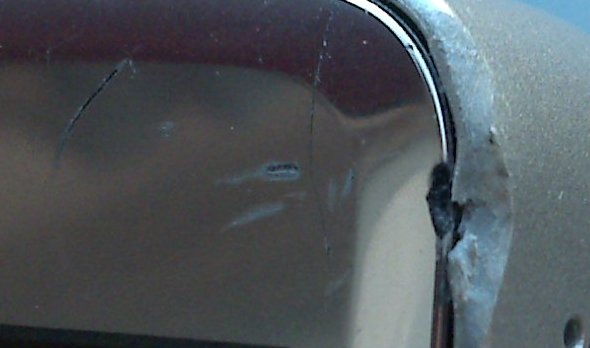
Have you ever dropped your phone? Of course you have. Probably more than once. Onto tarmac or concrete? Quite possibly. Even taking the greatest care in the world, most of my phones have been dropped at some time or other.
Yesterday, dazzled by the winter sun, I was running and tripped over a kerb. I went flying, landing heavily on both hands, which now bear plasters and various scars. In my right hand was my Nokia N82 and this took its share of the impact of the fall, handling my 12 stone or so of weight decelerating to zero in a fraction of a second (tell me about it....) A chunk of the case was carved out (as shown above in the main photo) and the bottom edge was badly abraded.

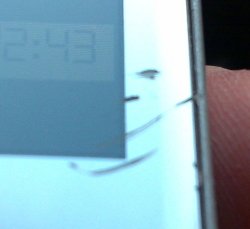
Normally, this would be curtains for a piece of high tech. After all, inside a gadget's casing are delicate circuit boards, ICs, a LCD screen, accelerometers, camera optics, flash bulbs, connection points, aerials, and so on. None of which are very robust on their own.
Yet you may remember my visit to Nokia's test labs in Farnborough recently, where I saw N79s (also candy bar designs) being put through tests that match up pretty well (and beyond) to what I subjected the N82 to (unintentionally). So, I was optimistic, once I'd gotten home and sorted out the 3 or 4 points at which I was bleeding(!), that the N82 would still work.
Not only does it still work, it's utterly flawless, I've tried everything from GPS to Xenon flash to Wi-Fi. No problems. My previous N82, a short term loan from WOM World, had been through the hands of about a dozen journalists across the world before it got to me, over the previous six months and it too bore a lot of scars. Yet, again, it still worked fine.
Re-living my fall, if an iPhone or Touch HD or N97 or Touch Pro or G1 or N95 (etc) had been in my right hand, do I think that any of these would have survived under the same circumstances?
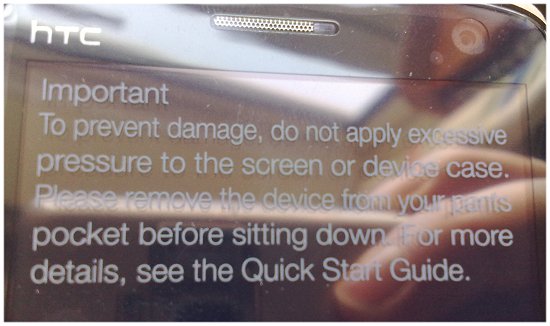
The warning on a new HTC Touch HD. When was the last time you saw a warning on a candy bar Nokia or Sony Ericsson phone about 'not putting the device in your pants pocket' etc? Not a dig at the Touch HD itself - it's actually quite nice in many ways - but more at the fragility of a large glass screen...
I'm pretty sure the iPhone or Touch HD's glass screen would be smashed. The N97's mechanism would be bent and would need replacing, plus the screen might be cracked, but I'd lay odds that the device would function to a degree (hey, it's a Nokia). The Touch Pro's plastic case would be cracked and pocked and the slide mechanism probably would be done for, along with the touchscreen. The N95, battery cover would be off, of course, the battery 10 yards down the road and the side panels would never fit properly again (though again I bet it would still boot up). The T-Mobile G1 (have you played with one?) would be in several large plastic pieces and you'd need to scrape it up off the street with a dustpan.
And yet the N82 works as well as the day it was made. In my book, robustness should be just as major a factor in buying a phone or smartphone as the camera or connectivity specs.
You may remember Rafe taking a similar fall and projecting his Nokia E71 into a river. After picking himself up, he fished around underwater for 10 minutes in icy water until he found the E71 - mainly because he wanted his SIM card back. The E71 had been buffeted around by the water and stones, underwater for all that time, with no warning or preparation. So obviously it was a complete goner.
Not so. As you may remember from Rafe's own account, he applied the usual cards-out, battery-out, rinse and dry/air thoroughly, immerse-in-rice (no, really....) routine:
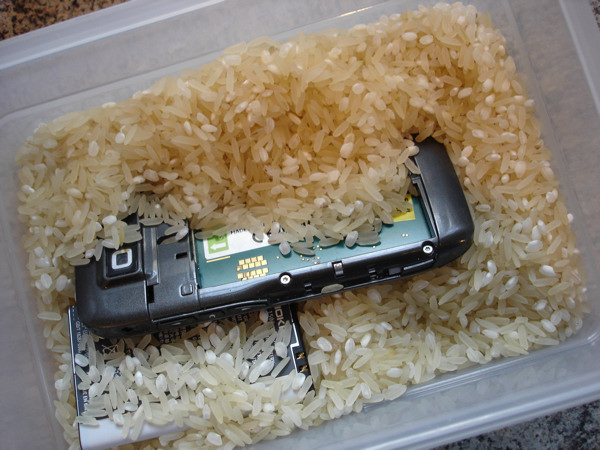
It came back to life in a day or so and now, as Rafe heads off to the USA for Mobius for a week, guess which device he's taking as his main smartphone? Yep, the E71. The screen leaks a bit of its backlight from the sides and the case is scuffed in places, but otherwise the E71 is working perfectly. Quite staggering. The E71 is, again, a candy bar, i.e. a monoblock form factor, so there was nothing to snap off and no mechanism to break.
So, with all this in mind, and having sown the thought in your mind that robustness is important in a phone, I thought I'd (subjectively) rate a variety of current and recent smartphones purely on their mechanical robustness. Which ones would best survive a fall? I've only listed hardware that I've physically owned or had access to for a significant length of time, so hopefully I'm scoring from experience here.
In decreasing order of robustness (i.e. most robust first, most fragile last):
- Nokia 5500 (forgotten by many, it seems, but still a current product, super-robust, even waterproof. Weak points were its tiny internal flash disk and small display)
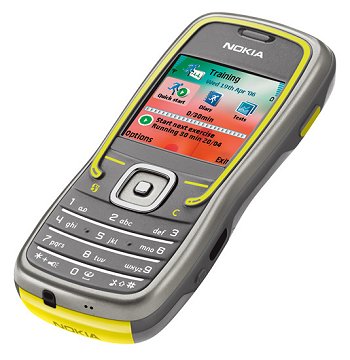
- Nokia E51 (my wife's had a dousing in a 'clean' toilet, was dried out and has worked perfectly for the next nine months to the current day)
- Samsung i7110 (reviewed a few days ago by me here, you may remember)
- Nokia E61i (you could knock nails in with this... the E61 was even tougher)
- Nokia N82 (as demonstrated above!)
- Nokia E90 (metal, metal, metal, despite the existence of the hinge mechanism - which is also metal)
- Samsung i550 (metal chassis, very solid indeed, but a little thin)
- Nokia N78 (similar to the N82 but not quite as confidence-inspiring and no camera cover)
- Nokia E71 (lots of fiddly keys to break or let in dust, but solid monoblock construction with plenty of metal)
- Samsung INNOV8 (good build quality, good slide, camera protected)
- Apple iPhone/iPod Touch (the glass front is surprisingly strong, but a sharp impact will still break it; early iPhones and iPod Touches had a metal case, too)
- Apple iPhone 3G (plastic back only)
- Sony Ericsson Xperia X1 (really well constructed side slider)
- Nokia N96 (a more secure slide mechanism than the N95's)
- Nokia N95 8GB (better slide, but no camera protection)
- HTC Touch Diamond
- Nokia N95 (wobbly slide and weak plastic sides, and all)
- Nokia N97 (ok, so I haven't played with this yet, but the touchscreen and number of mechanical components remain a slight concern)
- HTC Touch HD
- Nokia E70 (that huge swivelling hinge is a recipe for long term disaster, although mine never gave a moment's hesitation)
- HTC TyTN /TyTN II (solidly made for a qwerty slider, but ultimately that slide is a weak point, as are the sheer number of
- HTC Touch Pro
- Nokia N93 (I've NEVER dropped mine. I dread to think what would happen if I did)
- T-Mobile (Android) G1
* NB. There are no Blackberries in this list because I don't have enough hands-on time with these...
* NB2. I've omitted anything older than the N93, for lack of relevance to a buying decision today
* NB3. Many non-smartphones, e.g. the Sony Ericsson K850i, are also incredibly robust designs
Steve Litchfield, All About Symbian, 7 Dec 2008
